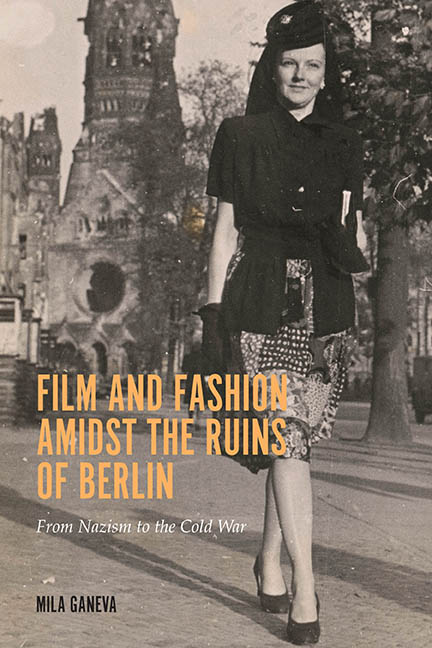Book contents
- Frontmatter
- Contents
- List of Illustrations
- Acknowledgments
- Introduction
- Chapter 1 Vicarious Consumption: Wartime Fashion in Film and the Press, 1939–44
- Chapter 2 “Fashions for Fräuleins”: The Rebirth of the Fashion Industry and Media in Berlin after 1945
- Vignette 1 Charlotte Glückstein: Historical Ruptures and Continuities in Postwar Fashion
- Chapter 3 Fashion amidst the Ruins: Revisiting Two Early Rubble Films,… und über uns der Himmel (1947) and Die Mörder sind unter uns (1946)
- Vignette 2 Hildegard Knef: Star Appeal from Fashion to Film
- Chapter 4 Farewell to the Rubble and Welcome to the New Look: Straßenbekanntschaft (1948) and Martina (1949)
- Chapter 5 Consuming Fashion on the Screens of the Early 1950s: Modell Bianka (1951), Frauenschicksale (1952), and Ingrid: Die Geschichte eines Fotomodells (1955)
- Epilogue
- Appendix 1 Principal Costume and Fashion Designers: Biographical Notes
- Appendix 2 Films and Newsreels Discussed
- Notes
- Bibliography
- Index
Chapter 1 - Vicarious Consumption: Wartime Fashion in Film and the Press, 1939–44
Published online by Cambridge University Press: 28 July 2018
- Frontmatter
- Contents
- List of Illustrations
- Acknowledgments
- Introduction
- Chapter 1 Vicarious Consumption: Wartime Fashion in Film and the Press, 1939–44
- Chapter 2 “Fashions for Fräuleins”: The Rebirth of the Fashion Industry and Media in Berlin after 1945
- Vignette 1 Charlotte Glückstein: Historical Ruptures and Continuities in Postwar Fashion
- Chapter 3 Fashion amidst the Ruins: Revisiting Two Early Rubble Films,… und über uns der Himmel (1947) and Die Mörder sind unter uns (1946)
- Vignette 2 Hildegard Knef: Star Appeal from Fashion to Film
- Chapter 4 Farewell to the Rubble and Welcome to the New Look: Straßenbekanntschaft (1948) and Martina (1949)
- Chapter 5 Consuming Fashion on the Screens of the Early 1950s: Modell Bianka (1951), Frauenschicksale (1952), and Ingrid: Die Geschichte eines Fotomodells (1955)
- Epilogue
- Appendix 1 Principal Costume and Fashion Designers: Biographical Notes
- Appendix 2 Films and Newsreels Discussed
- Notes
- Bibliography
- Index
Summary
In fashion, film is both dictator and captive.
—Review of Frischer Wind aus Kanada,
Der Silberspiegel, 1935WHEN GROSSSTADTMELODIE (Melody of a Great City, 1943, directed by Wolfgang Liebeneiner) premiered on October 4, 1943, in Berlin's Gloria-Palast cinema, at the beginning of the fourth year of war, the German home front was already suffering severely. City dwellers endured heavy bombardments and were getting used to decreasing rations of food and clothing. Berlin itself, the metropolis that is also a character in this film and a subject of cinematic adoration and exploration—the most popular song from the film was “Berlin, ich bin verliebt in dich bei Tag und Nacht”—would soon be destroyed beyond recognition. Yet it seemed that the prevailing wartime difficulties made the film all the more popular with audiences, especially women on the home front, because it was lavishly produced and offered an opportunity for escapist diversion.
Apart from a short sequence in which an enthusiastic Nazi rally is featured, the film's plot consciously transports the viewers back to the carefree prewar years, 1937 to 1939, when Berliners flocked en masse to various sites of entertainment: in-door bicycle races, beaches, ballrooms, and dazzling fashion shows. Reproduced on the screen, partly by means of documentary footage shot previously by Leo de Laforgue and Richard Angst, these spectacles created an almost déja vu impression of the heyday of the Weimar years, with the only difference that the various venues in the film are reassuringly in Aryan ownership: The publishing house Ullstein has become Deutscher Verlag and the fashion salons, previously the domain of the mostly Jewish-owned Berlin Konfektion sector, are now Aryanized and carry bland names such as “Elegante Herren-Moden” (Elegant Men's Fashion) and “Elegante Damen-Moden” (Elegant Ladies’ Fashion).
Rather than being coded as trivial, frivolous, and self-indulgent, the consumption of fashion in this popular 1943 production was actually celebrated within the film. Großstadtmelodie foregrounds prominently two visually attractive events. First is the striking sartorial transformation of its magnetic female protagonist, the photographer Renate Heiberg (played by a young Viennese actress, Hilde Krahl, soon the wife of the director, Liebeneiner).
- Type
- Chapter
- Information
- Film and Fashion amidst the Ruins of BerlinFrom Nazism to the Cold War, pp. 21 - 46Publisher: Boydell & BrewerPrint publication year: 2018



